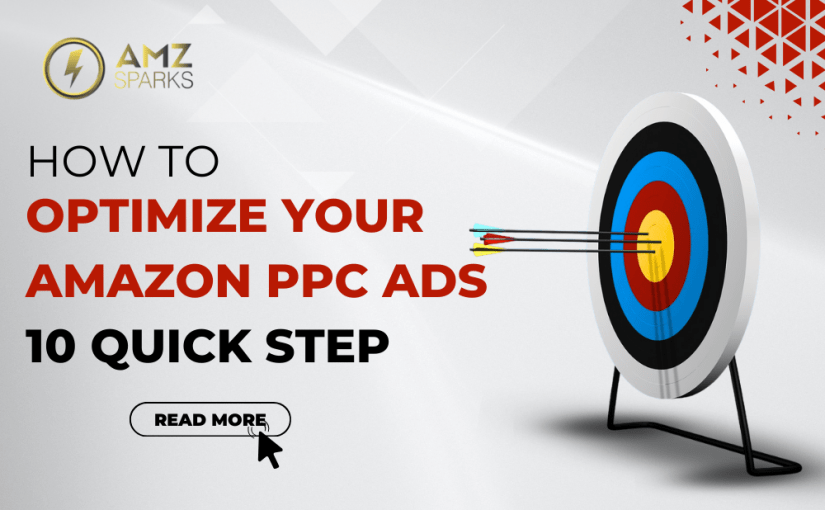Amazon’s online marketplace has flourished for over 20 years, with many sellers achieving substantial success, some even reaching millions in sales.
However, the competition is intense. Sellers can gain an edge by effectively using Amazon PPC ads. These ads increase product visibility, attract shoppers, and boost sales.
This is where Amazon PPC Management comes in. These services assist sellers by targeting specific keywords, ensuring you only pay when someone clicks your ad, making it a cost-effective strategy to reach potential customers.
In Summary This guide outlines the essential steps to enhance your Amazon PPC campaigns. It covers everything from setting goals to optimizing performance, helping you increase your sales.
Why Optimize Amazon PPC Ads? Improving Amazon PPC campaigns is crucial for several reasons:
Studies indicate that the top 3 results in Amazon searches receive significantly more clicks than those in regular listings. Strengthening your PPC ads can help you reach these prime spots.
Moreover, Amazon ads have higher conversion rates. Research shows that people who click on Amazon PPC ads are more likely to purchase than those who click on other online ads. This results in a better return on investment (ROI). By continually refining your PPC ads, you can outperform competitors, gain more clicks, and ultimately increase sales.
Another advantage of Amazon PPC is the wealth of valuable data it provides. By analyzing metrics such as click-through rate (CTR), sales generated by ads, and cost per click (CPC), you can gain insights into your target audience and improve your ads further.
Step 1: Define Your Goals
Identify your target. Are you aiming for more sales, brand recognition, or increased product visibility? Clarifying your objectives helps you create more focused and effective PPC ads. Write down your goals to ensure you hit your targets.
Once you’ve identified your goals, make them SMART:
Specific: Clearly define what you want. Measurable: Easily track your progress. Achievable: Set realistic goals. Relevant: Ensure they align with your business. Time-bound: Set a deadline to stay motivated.
Instead of a vague goal like “increase sales,” a SMART goal could be “boost sales by 20% in 3 months with effective PPC ads.”
Step 2: Know Your Audience
To master Amazon PPC, you must understand your target audience.
Identify your ideal customers on Amazon. Understand their demographics, such as age, gender, location, and income level. Know their preferences, interests, and buying behaviors. Utilize tools like Amazon’s analytics and external market research resources. The more you know about your audience, the better you can tailor your PPC campaigns to meet their needs.
Step 3: Keyword Research
Finding the right keywords is essential for success with Amazon PPC. Tools like Amazon’s Keyword Tool, Helium 10, or Jungle Scout can help you discover what your target audience is searching for.
Look for keywords with high search volume but low competition to increase your ads’ visibility. Ensure the keywords are relevant to your products and match what people are looking to buy. Aim for longer, more descriptive keywords that are likely to convert into sales.
Step 4: Create Compelling Ads
Grab attention with your first words! Create eye-catching ads with the following tips:
Attention-Grabbing Headlines The headline is the first thing buyers see, so make it impactful. For example, instead of a generic headline like “High-Quality Backpack,” use something like “Get the Ultimate Backpack for Outdoor Adventures.”
Persuasive Ad Copy Focus on the benefits of your product rather than just its features. Explain how your product can improve customers’ lives or solve their problems.
Highlight Unique Selling Points What makes your product stand out from the competition? Is it superior quality, innovative features, or unbeatable value? Emphasize these aspects to convince shoppers to choose your product over others.
Step 5: Optimize Product Listings
Follow these tips to ensure your listings are optimized for success:
Incorporate relevant keywords into your product titles, bullet points, and descriptions to enhance discoverability. Use high-resolution images that showcase your product from multiple angles and highlight its key features. Write clear and compelling product titles and bullet points that communicate the benefits of your product and entice shoppers to learn more.
Step 6: Set Up Targeted Campaigns
Consider your advertising goals and select the campaign type that aligns best with them. Sponsored Products, Sponsored Brands, and Sponsored Displays each have their strengths and can achieve different objectives.
Sponsored Products: Promote specific products on search results and product pages—great for driving sales. Sponsored Brands: Showcase your brand with a logo, headline, and multiple products—ideal for brand awareness. Sponsored Displays: Reach customers beyond Amazon searches—useful for retargeting and reaching new audiences. Choose the campaign that best suits your goals.

Step 7: Monitor Performance Regularly
Keep an eye on your ads! Track clicks (CTR), how many clicks turn into sales (conversion rate), and cost per customer (CPA) to see if they’re working.
Once you get the data, you can make changes to make them better.
For example, if you see that some words or ads are doing really well, you can spend more money on them. But if some parts of your ads aren’t doing so well, you can change them to make them work better.
It’s all about using the information you have to make your ads the best they can be.
Step 8: Test and Iterate
Optimization of your PPC campaigns demands testing of different elements. You have to try out some multiple things like ad creatives, keywords, and targeting (location) options to see what works best for your audience and what needs improvements. This process of testing is known as A/B testing.
A/B testing is vital to identify and tweak elements of your PPC campaigns for better ROI. Don’t hype it! It is a slow process, better have patience and test every aspect thoroughly.
Keep Learning, Keep Winning!
The more you test and analyze your ads, the better they get! Use what you learn to fine-tune your campaigns over time. This will bring you faster results and keep your product on top for the long haul!
Step 9: Adjust Bids and Budgets
Consider increasing your bids to maximize visibility if specific keywords are showing promising results and a lot of clicks and conversions. Your ads will appear higher in search results, increasing clicks and income by bidding higher on specific keywords.
You may want to cut your prices or suspend them if specific keywords are underperforming. This can help you stop spending on unproductive keywords and redirect your budget to more profitable ads. Regularly evaluating and revising bids and budgets optimizes ad spend and campaign performance.
Step 10: Analyze and Optimize
Once your campaigns are running, it’s time to become a data detective! Take a close look at the numbers to see what’s working well and what needs tweaking.
Spot trends: Are certain keywords bringing in more sales? Are some ad versions getting more clicks?
Fix what’s flopping: Identify keywords or ad copy that aren’t performing and make adjustments.
Focus on the winners: Put more effort into what’s driving results!
Make strategic changes to your campaigns to optimize ROI (Return on Investment) based on these results. This includes adjusting bids and budgets, refining ad copy and targeting, or testing new strategies. Regular optimization of your campaigns based on data-driven insights is vital to expand your business and sales growth.
Conclusion
Amazon PPC Management has now become essential for selling on Amazon. You can increase sales and build your business by changing your adverts and seeing what works. Keep testing, watching, and improving to stay ahead. Try it and watch your Amazon sales rise!
